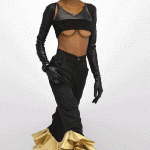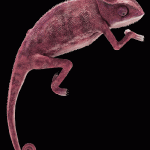Do you also sell rolls for web printing? Can I use this with a flexo press?
Yes, we can supply MicroFlex rolls for label printing and also 100 and we also have 150LPI rolls in stock.
Lenticular is a high-resolution process so we recommend the highest resolution.
Click here to see a 150LPI roll in a web printing press.
How can we find out how to enter the sheets in the press?
We are printing inkjet information on our sheets.
This inkjet information is always printed on the guide side of the sheet when the lenticules are parallel to the short edge and on the “gripper” side when the lenticules are parallel to the long edge…
Is it possible to print lenticular images in screen printing?
Lenticular is a HIGH-RESOLUTION process as the lenticular sheet is magnifying the data that is printed to the backside of the lens. Screen printing does not allow the resolution required for good quality.
Our clients are offset or digital printers, printing at high res. like 400 LPI or even more. This is impossible with screen printing today. Today the large format lenticular images are printed on flatbed printers, you’ll see a list of printers here.
I am printing a job and I notice that I have a problem. What’s the best thing to do?
Please contact us as soon as possible. The most important is to avoid wasting material.
We’ll be able to help you to determine the origin of the problem and to solve the issue.
Is 3D Products SRL – DPLenticular printing the plastic sheets?
No, we don’t as we are only selling lenticular clear sheets to the offset printing industry.
But we are promoting this business and helping our customer’s to build the market.
So you can ask us for a quote on a final printed product by filling out the following form (we’ll forward it to a printer of course) and check some samples from many different printers on our lenticular imaging page.
Can we print a lenticular with a DI press (Presstek)?
Of course, this is possible. Depending of the drying system installed on your DI (infrared or UV) you’ll need to select the right inks for perfect adherence on the lenstar lenticular plastic sheet.
Our lenticular sheets won’t require any “precoating” to be printed on a DI press (Presstek, Ryobi, Kodak, …).
Can your sheets also be used for ordinary laser or inkjet printers? Which specifications does the printer have to meet?
As you can read on our website, our sheets are designed for litho offset and digital printing.
Today large format images are printed on flatbed devices but, if you don’t have a flatbed, it’s possible to laminate a high-resolution print to the back of a lens, using our High-Quality Crystal Clear Mount Double Side Adhesive Film, see the info about small quantities. Laser print is not recommended.
Which blankets would you recommend for lenticular jobs?
We recommend non-compressible blankets.
We believe that a premium quality blanket with a more firm surface allows the printing to be performed with less image distortion. We have experienced good results with the UV Blankets that are listed on our links page.
Using a low-tack ink is also helpful. Since a Lenticular job requires a perfect make-ready with the lowest possible pressures between plate and blanket, and blanket to the substrate, our choice for blankets is to use a premium conventional blanket with a high durometer, and very good ink release, in combination with low tack inks.
You’ll find useful links on the folowing page
What is the pitch and a pitch checker? Why do we need to perform a pitch test?
The pitch is the exact size of the lenticule. It means that it will not be 75.00 LPI, but as a sample 75.48 or another digit depending on the production lot and your output device.
Before interlacing, it is necessary to determine the exact pitch of the lenticular sheet.

We have RGB color pitch tests for digital printing.
Why are there pitch variations?
The first difference is due to the pattern roll that is used. Our extruder, Pacur, is using 3 dedicated extrusion lines which means that these lines would work with different pattern rolls. We also know that we need backups.
Each pattern roll will be slightly different than an other.
We never consider materials produced by two different lines as being the same production lot.
One production lot has been produced using the same line and the same pattern roll.
The second element would be the production conditions. We know by experience (after selling dozens of million sheets) that the variation during the production would not exceed +/- 0.01%. This is within one production lot. We are convinced that the stability of the pitch produced by Pacur is actually the best we can find in the extrusion world.
The difference from one lot to another is also not very important as we noticed not more than 0.02LPI difference using the same pattern roll.
We noticed that some other producers are indicating the pitch on each pallet and that each pallet can have a different pitch. Our customers know that this is never the case with our material.
The indication of “pitch range” that we are publishing on our product pages is corresponding to the differences we could see from one output device to another other but this is NEVER corresponding to a pitch variation of the material.
So the biggest pitch variation, for OUR lenticular sheets, is not due to the production of the plastic.
Important differences are due to the different output devices. From one print shop to another, we can see that the same production lot will have a different pitch as each CTP has a different calibration. We also experienced that the pressure on the press will have an important impact on the pitch, particularly when printing with the lenticules parallel to the grippers. More pressure will give a “shorter” pitch and this is the reason why we recommend printing the pitch test.
And, last but not least, the pitch will, of course, depend on the viewing distance of the lenticular image. This is why the “visual pitch” will be the best result at the given viewing distance of the final image.
The precision of the pitch test is crucial so that the information will exactly match the size of the lenticule.

If, for example, the test shows that the optical pitch is 75,48 LPI, you will thus interlace 16 images in
75,48 X 16 = 1207,68 LPI.
The mechanical pitch will be determined using a magnifying glass.
I use your 60 LPI & 100 LPI lenticular lenses. I am using HP Indigo, in 812 DPI, but the result is not what we expected. I see vertical lines (wide 1 inch) Which resolution is recommended for HP Indigo 3050?
First of all the HP Indigo will require a special coating and screening, we have specially coated material in stock. If the maximum resolution (with lenticular option) is 812 DPI your file should have a resolution of 812 DP
60LPI x 13 images =780DPI & resampling @ 812DPI
101LPI x 8 images = 808DPI & resampling @ 812DPI
This is not a high resolution compared to offset printing although HP Indigo can provide a good quality;
How can I laminate a photographic print to the backside of a lenticular sheet?
We recommend using our High-Quality Crystal Clear Mount Double Side Adhesive Film. More information is on this page.
There is an interesting video on the 3D Masterkit site.









